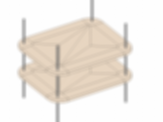1-1963 STINGRAY
Member:
Date Updated:
September 14, 2017
The 1963 Corvette received a major restyling, new mechanics and a new name "Stingray". Zora Arkus-Duntov convinced the brass at GM to include independent rear suspension on the '63 because he convinced them he could sell 30,000 cars if they had it. The passenger compartment was still kept far to the rear of the car to allow the engine/transmission to sit behind the centerline of the front wheels. This allowed for a better weight ration (47/53) that improved handling. The '63 Corvette included new twin headlights that are hidden behind an electrically operating cover. This added to the aerodynamics of the car when the headlights were not in use. The fastback coupe was also new, it included a fixed roof with a large back window that was split down the center with a body colored bar. This bar was very controversial and was removed in 1964 so it makes the '63 very unique. The car now had recessed non-functional hood louvers. Front fender louvers and ribbed rocker panels replaced the coves on the earlier models. The coupe also has louvers at the back of the side windows. The dash has circular gauges with black faces and the earlier models have storage space under the seats. Air conditioning, power brakes and power assisted steering were now available options. In the middle of the production year the 4-speed manual transmission was transitioned to a four-speed manufactured at the Muncie, Indiana plant, before that the transmission was built by Borg-Warner.










